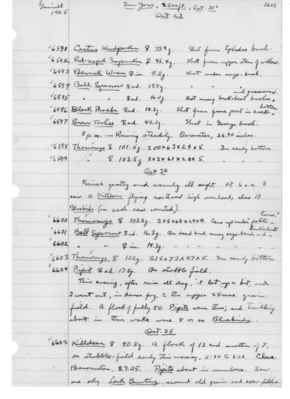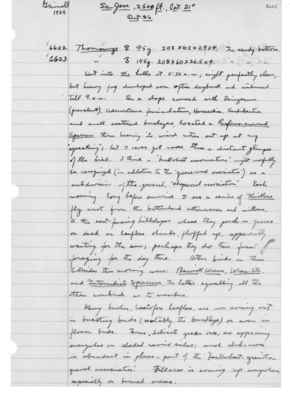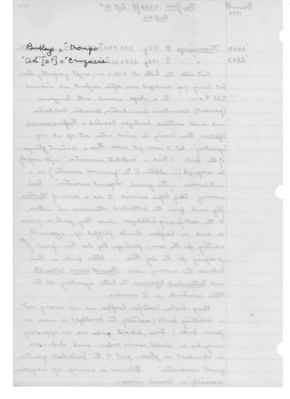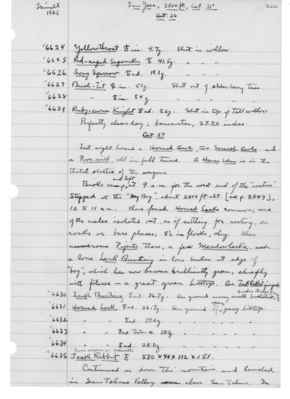Pages
S3 Page 60
Collector: Grinnell - 1925 Location: San Jose, 2500 ft., lat. 31° Date: Oct. 23 Page Number: 2603 6591 Cactus Woodpecker (female sign)37.4g. Shot from Ephedra bush. 6592 Red-naped Sapsucker (female sign) 46.4g. Shot from upper stem of willow. 6593 Bewick Wren (female sign) im. 9.2g. Shot under sage-bush. 6594 Bell Sparrow (male sign) ad. 15.7g. Shot under sage-bush. 6595 Bell Sparrow (male sign) ad. 16.0g. Shot among buckwheat bushes and greasewood. 6596 Black Phoebe ad. 18.3g. Shot from fence post in creek bottom. 6597 Brown Towhee (male sign) ad. 42.1g. Shot in Garrya bush. 5 p.m. -- Raining steadily. Barometer, 26.90 inches. 6598 Thomomys (female sign) 101.5g. 200x63x29x5. In sandy bottom. 6599 Thomomys (female sign) 103.5g. 203x61x28x5. In sandy bottom. Oct. 24 Rained gently and warmly all night. At 5 a.m. I saw 10 Killdeers flying northwest high overhead; also 10 Bluebirds (in each case counted). 6600 Thomomys (female sign) 103.2g. 205x68x29x4. Came up under "potato house." 6601 Bell Sparrow (male sign) ad. 16.3g. On dead bush among sage-bush and buckwheat. 6602 Bell Sparrow (female sign) im. 14.3g. On dead bush among sage-bush and buckwheat. 6603 Thomomys (male sign) 122g. 215x73x27x5. In sandy bottom. 6604 Pipit (female sign) ad. 17.5g. On stubble field. This evening, after rain all day, it let up a bit, and I went out, in dense fog, to the upper 25-acre gain field. A flock of fully 50 Pipits were there; and trailing about in their wake were 8 or so Bluebirds. Oct. 25 6605 Killdeer (male sign) 90.8g. A flock of 13 and another of 7, on stubble-field early this morning, 5:30-6:00. Clear Barometer, 27.05. Pipits about in numbers. Saw one shy Lark Bunting, around old grain and corn fields.
S3 Page 61
Collector: Grinnell - 1925 Location: San Jose, 2500 ft., lat. 31° Date: Oct. 25 Page Number: 2604 6606 Townsend (?) [sic] Warbler (female sign) ad. 8.7g. Shot in willows; alone; the first of this warbler I have seen, tho Lamb has seen two. 6607 Black-throated Gray Warbler (female sign) im. 8.5g. Shot in willow. The only one of its species seen this trip. 6608 Yellowthroat (female sign) im. 9.2g. Shot in willow. 6609 Yellowthroat (female sign) ad.8.9g. Shot in sagebush near willows. 6610 House Wren (male sign) im. 10.3g. shot in sage-bush; 2 others noted today. 6611 Chipping Sparrow (male sign) im. 12.6g. One of flock of 12 +/- in old field among weeds. 6612 Song Sparrow (male sign)(?sic) im. 17.9g. Shot in willows. 6613 Song Sparrow (male sign) ad. 19.2g. Shot on sage-bush near willows 6614 Song Sparrow (female sign) im. 19.1g. Shot in willows. 6615-18 Uta. 4 examples from under one piece of old tin on sandy bottom. 6619 Pituophis (Gopher Snake) Length 59 1/2 in., measured. In orchard, in weeds and grass. 6620 Microtus (male sign) jv. 21.5g. 132x40x21x10. Bro't to house by cat! Today was sunny and brilliant -- a welcome change from the cloudiness of the preceding several days, Was out two hours, 8 to 10, mostly in the willow bottom above the ranch. Besides comments made above: Saw 3 Cooper Hawks, each going down the valley; Tree Swallow ( one lone bird flying southeast); Audubon Warbler ( about 4); Ruby crowned Kinglet (2); Pileolated Warbler (1); Marsh Wren (1); Linnet ( about 60; Meadowlark (2); Brewer Blackbird (3); Say Phoebe (2); Bush-tit (2 companies); Bewick Wren (5 +/-). Oct 26 6621 Reithrodontomys (male sign) 11.1g. 147x78x17x11. In mouse trap in rank vegetation (nettles, nightshade, melutha???, grass) along irrigation ditch.
S3 Page 62
Collector: Grinnell - 1925 Location: San Jose, 2500 ft., lat. 31° Date: Oct. 26 Page Number: 2605
6622 Thomomys (female sign) 95g. 203x62x29x4,. In sandy bottom. 6623 Thomomys (male sign) 145g. 208x60x26.5x4. In sandy bottom. Out into the hills at 5:30 a.m.; night perfectly clear, but heavy fog developed soon after daybreak and continued till 9. a.m. On a slope covered with Eriogonum (prevalent), Adenostoma fasciculatum, Hosackia, Andibertia, and small scattered buckeyes, located a Rufous-crowned Sparrow thru hearing its weird notes set up at my "squeaking"; but I never got more than a distant glimpse of the bird. I think a "buckwheat association" might usefully be recognized (in addition to the "grease-wood association") as a subdivision of the general "chaparral association." Each morning long before sunrise I see a series of Flickers fly west from the bottomland cottonwoods and willows, to the east-facing hillslopes where they perch on yuccas or dead or leafless shrubs, fluffed up, apparently waiting for the sun; perhaps they do their first foraging for the day there. Other birds on these hillsides this morning were; Bewick Wrens, Wren-tits, and Intermediate Sparrows, the latter equaling all the other combined as to numbers. Many bushes, heretofore leafless, are now coming out in bursting buds (notably the buckeye) or even in flower buds. Ferns, delicate green ones, are appearing everywhere in shaded ravine sides; and club moss is abundant in places -part of the "buckwheat-granite gravel association." Fillaree is coming up everywhere, especially in burned areas.
S3 Page 64
Collector: Grinnell - 1925 Location: San Jose, 2500 ft., lat. 31° Date: Oct. 26 Page Number: 2606 6624 Yellowthroat (male sign) im. 9.7g. Shot in willow. 6625 Red-naped Sapsucker (male sign) 41.5g. Shot in willow. 6626 Song Sparrow (male sign) ad. 18.1g. Shot in willow. 6627 Bush-tit (female sign) im. 5.1g. Shot out of elder-berry tree. 6628 Bush-tit (male sign) im. 5.4g. Shot out of elder-berry tree. 6629 Ruby-crown (sic) Kinglet (female sign) ad. 5.6g. Shot in top of tall willow. Perfectly clear day; barometer, 27.20 inches.
Oct. 27 Last night heard a Horned Owl, two Screech Owls and a Poor-will, all in full tune. A House Wren is in the thatch shelter of the wagons.
Broke camp and left at 9 a.m. for the west end of the 'section." Stopped at the "dry bog", about 2800 ft. alt. [see p. 2549], 10 to 11 a.m.. There found Horned Larks common, some of the males isolated out, as if settling for nesting, on rocks or bare places; (female sign)'s in flocks, shy. Also numerous Pipits there, a few Meadowlarks, and a lone Lark Bunting in low bushes at edge of "bog", which has become brilliantly green, chiefly with filaree -- a great green hilltop. One Jack rabbit jumped. 6630 Lark Bunting (male sign) ad. 36.7g. On ground among small buckwheat borders(?)at edge of (??). 6631 Horned Lark (male sign) ad. 26.7g. On ground of open grassy hilltop. 6632 Horned Lark (male sign) ad. 27.0g. On ground of open grassy hilltop. 6633 Horned Lark (male sign) ad. testes. 0. 28.0g. On ground of open grassy hilltop. 6634 Horned Lark (male sign) ad. 28.0g. On ground of open grassy hilltop. 6635 Jack Rabbit (male sign) 530x90x112x151. Continued on down the mountain and landed in San Telmo valley (strikeout) above San Telmo. In




